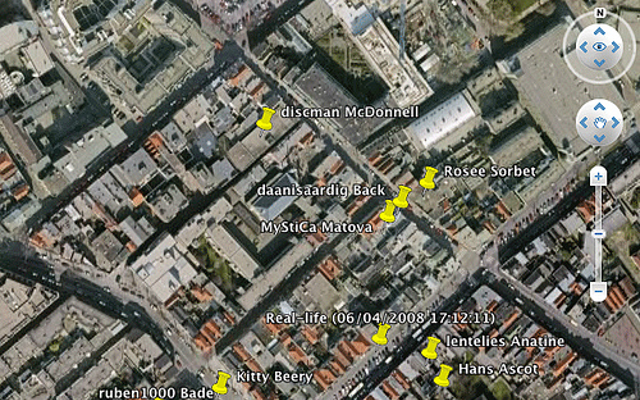Augmented Reality – The New Reality?

Using a virtual to real-world conversion mechanism, the location of Second Life avatars is converted to locations on the map of The Hague. Carrying a GPS device, a group of walking tour participants will explore the real-life manifestation of the virtual world, interacting with the avatars in their vicinity. (Creative Commons by Overig on Flickr.com)
The Marketing Consigliere does not make it a habit to hobnob with the journalistic class, but living in the Washington DC area makes it hard to avoid. And when a journalist is a paisano, that makes it even harder- occasionally, he has had the good fortune of bumping into the Washington Post‘s Rob Pegoraro, so he makes it a point to follow him on Twitter and read his technology columns in the Business section of this great newspaper – probably more often then he bothers to read Walt Mossberg‘s articles.
Rob’s article in the November 22nd issue of the Post, ‘Augmented Reality’ fuses the Web and the world around you, provides a basic and thorough explanation of a promising tool for consumers and marketers. It led the Marketing Consigliere to think more about this…
Augmented Reality (AR) represents a real-time perspective of a brick and mortar environment that is combined with computer processed data and symbols and images, thus creating an “augmented” view of reality. While many people today associate AR to gaming, its roots are back in the military. The idea of a jet pilot understanding threats or aiming and maneuvering a fired missile by directing a look has been on the drawing board for decades and is finally being tested. An entire industry catering to the military’s AR needs from a modeling, simulation, and training aspect has arisen and their largest conference, I/ITSEC, starts this month:
But outside of a training environment, what is the value of AR? With applications on the iPhone and Droid devices as described by Rob Pegoraro, clearly there is utility for B2C marketing, especially when involving location-based advertising or user generated content. But what about for B2B companies – Can AR be useful in that arena? Here are some ways that it could be done:
Advertising & Branding: B2B Marketers could deploy interactive AR applications to help explain complex products and services. For example, GE‘s Smart Grid Augmented Reality came out earlier this year with much buzz because it can safely engage customers in simulations either that are too dangerous or costly to really do in real life.
Support with complex tasks: Multi-faceted processes such as manufacturing or maintenance may be reduced in complexity by merging relevant data onto a control monitor. For example, data can be virtually labeled on components of an operating turbine to provide real time stats and find relationships to potential points of failure to the system. AR can reveal otherwise hidden things or remote objects within a system such as the human body for medical diagnostics or a supply chain for building construction.
Transportation & Navigation: As in the example illustrated in Rob Pegoraro’s column, the GIS based applications can assist fleet managers, truck operators with real-time traffic information. And just as military pilots have head up displays in their cockpit, it won’t be long before truckers have converged information on their windshields instead of primitive GPS navigational and restaurant finding devices many of us have in our cars.
Research & Collaboration: AR can help facilitate collaboration among distributed team members via conferences with real and virtual participants. Just as business partners use web conferencing and even virtual worlds like Second Life for training and meetings, AR can be used to enable interactive exploration and analysis of environmental characteristics, 3-D mapping and schematics of plans or products, and even make modifications to those objects.
While AR is just starting out, we’ll be seeing more mash-ups of data and applications that will be useful to B2B organizations, and especially the marketers within them. Hopefully B2B firms won’t converge data just for the sake of converging data; there may be a lot of clutter but perhaps giving the end user filtering capabilities so they have the exact data they need and no more will be key.
